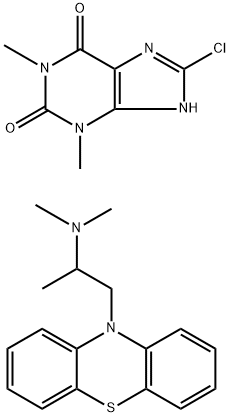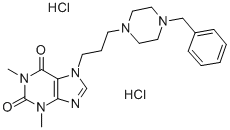Aminophylline
Synonym(s):(Theophylline)2 · Ethylenediamine;3,7-Dihydro-1,3-dimethyl-1H-purine-2,6-dione, cmpd. with 1,2-ethanediamine (2:1);Theophylline hemi(ethylenediamine) complex
- CAS NO.:317-34-0
- Empirical Formula: C9H16N6O2
- Molecular Weight: 240.27
- MDL number: MFCD00013221
- EINECS: 206-264-5
- SAFETY DATA SHEET (SDS)
- Update Date: 2024-12-18 14:15:32

What is Aminophylline?
Description
Aminophylline is a 2/1 mixture of theophylline and ethylenediamine. It caused contact dermatitis in industrial plants, in pharmacists, and in nurses. Ethylenediamine is the sensitizer, and patch testing is generally positive to both ethylenediamine and aminophylline, but negative to theophylline.
Chemical properties
white to slightly yellowish powder
Originator
Memcophylline,Memphis Co.
The Uses of Aminophylline
Aminophylline is a bronchodilator and a non-selective phosphodiesterase (PDE) inhibitor.
The Uses of Aminophylline
Bronchodilatator;Mastocytes degranulation inhibitor
The Uses of Aminophylline
Aminophylline exhibits vasodilatory and anti-inflammatory activity and is occasionally clinically used to treat chronic obstructive pulmonary disorder (COPD). In animal models of allergen-induced lung inflammation, aminophylline decreases levels of IL-5, IL-8, and eosinophils. It is mostly used to prepare solutions for intravenous injections.
What are the applications of Application
Aminophylline is a non-selective PDE (phosphodiesterase)inhibitor
Background
Aminophylline is a drug combination that contains theophylline and ethylenediamine in a 2:1 ratio. Once in the body, theophylline is released and acts as a phosphodiesterase inhibitor, adenosine receptor blocker, and histone deacetylase activator. Similar to other theophyllines, aminophylline is indicated for the treatment of lung diseases such as asthma, chronic bronchitis, and COPD. The majority of aminophylline medications are discontinued and the remaining medications on the market are in short supply.
Indications
For the treatment of bronchospasm due to asthma, emphysema and chronic bronchitis.
Definition
ChEBI: Aminophylline is a mixture comprising of theophylline and ethylenediamine in a 2:1 ratio. It has a role as a bronchodilator agent and a cardiotonic drug. It contains a theophylline and an ethylenediamine.
Manufacturing Process
A mixture of 198 g (1 mol) theophylline and 60-78 g (0.75-1 mol) ethylenediamine hydrate in 300 g of water was stirred at 50°C and then the mixture was concentrated in vacuo. The product (aminophylline) was separeted by suction filtration. Aminophylline was used as an aqueous solution.
brand name
Phyllocontin (Purdue Frederick); Somophyllin (Fisons); Truphylline (G & W);Afonilum;Aminomal;Aminophylline injection;Aminophylline mudrane;Aminophylline oral;Amino-slow;Amnivent;Asmafilin;Cardophylline;Carine;Colonofilin;Corfilamine;Corophylline;Corphyllamin;Duraphyllin;Escophylline;Eudiamine;Euphyllin 0.48;Euphyllin retard;Euphylllin cr;Euphylllina;Fadfilina;Godafilin;Jaa aminophylline;Mini-lix;Mudrane gg;Mundiphyllin;Palaran;Palaron;Pecram;Pecran;Peterphylin;Phyllotemp;Planphylline;Somophyllin-12;Syntophyllin;Teophyllamin;Thodrox;Variaphylline.
Therapeutic Function
Diuretic, Cardiac stimulant, Smooth muscle relaxant, Vasodilator
World Health Organization (WHO)
Aminophylline, the ethylenediamine salt of theophylline, was introduced many years ago as a treatment for asthma and is listed in the 8th WHO Model List of Essential Drugs. It has been recognized for some 10 years that aminophylline preparations are not interchangeable because bioavailability can vary considerably. The resulting variability in drug absorption can lead to adverse effects including irritation of the mucosa. Allergic reation can also be an adverse effect of aminophylline. Theophylline functions similarly but is considered less of an irritant.
Hazard
Cardiovascular and respiratory collapse.
Contact allergens
This drug is a 2:1 mixture of the alkaloid theophylline and ethylenediamine (see below). It caused contact dermatitis in industrial plants, pharmacists, and nurses. Ethylenediamine is the sensitizer and patch testing is generally positive to both ethylenediamine and aminophylline and negative to theophylline.
Pharmacokinetics
Aminophylline is the ethylenediamine salt of theophylline. Theophylline stimulates the CNS, skeletal muscles, and cardiac muscle. It relaxes certain smooth muscles in the bronchi, produces diuresis, and causes an increase in gastric secretion.
Clinical Use
Reversible airways obstruction
Acute severe asthma
Veterinary Drugs and Treatments
The theophyllines are used primarily for their bronchodilatory effects, often in patients with myocardial failure and/or pulmonary edema. While they are still routinely used, the methylxanthines must be used cautiously due to their adverse effects and toxicity.
Drug interactions
Potentially hazardous interactions with other drugs
Antibacterials: increased concentration with
azithromycin, clarithromycin, erythromycin,
ciprofloxacin, norfloxacin and isoniazid; decreased
erythromycin levels if erythromycin is given
orally; increased risk of convulsions if given with
quinolones; rifampicin accelerates metabolism of
aminophylline.
Antidepressants: concentration increased by
fluvoxamine - avoid or halve theophylline dose and
monitor levels; concentration reduced by St John’s
wort - avoid.
Antiepileptics: metabolism increased by
carbamazepine, phenobarbital and primidone;
concentration of both drugs increased with
fosphenytoin and phenytoin.
Antifungals: concentration increased by fluconazole
and ketoconazole.
Antivirals: metabolism of aminophylline increased
by ritonavir; concentration possibly increased by
aciclovir.
Calcium-channel blockers: concentration increased
by diltiazem and verapamil and possibly other
calcium-channel blockers.
Deferasirox: concentration of aminophylline
increased.
Feboxostat: use with caution.
Interferons: reduced metabolism of aminophylline.
Tacrolimus: may increase tacrolimus levels.
Ulcer-healing drugs: metabolism inhibited by
cimetidine; absorption possibly reduced by sucralfate.
Metabolism
Not Available
Metabolism
Aminophylline is metabolised to theophylline in vivo. Theophylline is excreted in the urine as metabolites, mainly 1,3-dimethyluric acid and 3-methylxanthine, and about 10% is excreted unchanged.
Properties of Aminophylline
| Melting point: | 269-270 °C |
| storage temp. | Inert atmosphere,Store in freezer, under -20°C |
| solubility | H2O: 3.7 mg/mL solutions should be freshly prepared. |
| form | powder |
| pka | pKa 5.0 (Uncertain) |
| color | white to off-white |
| Water Solubility | soluble |
| Merck | 14,465 |
| InChI | InChI=1S/C7H8N4O2.C2H8N2/c1-10-5-4(8-3-9-5)6(12)11(2)7(10)13;3-1-2-4/h3H,1-2H3,(H,8,9);1-4H2 |
| CAS DataBase Reference | 317-34-0(CAS DataBase Reference) |
| EPA Substance Registry System | 1H-Purine-2,6-dione, 3,7-dihydro-1,3-dimethyl-, compd. with 1,2-ethanediamine (2:1) (317-34-0) |
Safety information for Aminophylline
| Signal word | Danger |
| Pictogram(s) |
 Skull and Crossbones Acute Toxicity GHS06 |
| GHS Hazard Statements |
H301:Acute toxicity,oral |
| Precautionary Statement Codes |
P301+P310:IF SWALLOWED: Immediately call a POISON CENTER or doctor/physician. |
Computed Descriptors for Aminophylline
| InChIKey | LHRHXWBJUQKYEL-UHFFFAOYSA-N |
| SMILES | O=C1N(C(=O)N(C)C2NC=NC1=2)C.C(N)CN |
Aminophylline manufacturer
KPS Chemicals And Pharmaceuticals
New Products
1-Amino-1-cyclohexanecarboxylic acid Cycloleucine 6-Bromo-3-iodo-1-methyl-1H-indazole 3-(2,4-Dimethoxybenzyl)dihydropyrimidine-2,4(1H,3H)-dione 7-Bromo-1H-indazole ELECTROLYTIC IRON POWDER 2-Methyl-2-phenylpropyl acetate 1-Aminocyclobutanecarboxylic acid 1-(2-Ethoxyethyl)-2-(piperidin-4-yl)-1H-benzo[d]imidazole hydrochloride Decanonitrile tert-butyl 4-(1H-benzo[d]iMidazol-2-yl)piperidine-1-carboxylate 4-Ethylbenzylamine Methyl 5-bromo-2-chloro-3-nitrobenzoate N-(5-Amino-2-methylphenyl)acetamide 2-Chloro-3-nitropyridine 5-Bromo-2,3-dimethoxypyridine methyl 6-chloro-2-(chloromethyl)nicotinate 2-methoxy-4-methyl-5-nitro pyridine 2-iodo-5-bromo pyridine 2-amino-4-methyl-5-nitro pyridine 5-Fluoro-2-Oxindole methyl L-alaninate hydrochloride diethyl L-glutamate hydrochloride Ethyl tosylcarbamateRelated products of tetrahydrofuran



![8-[2-(4-benzhydrylpiperazin-1-yl)ethyl]-1-methyl-3-(2-methylpropyl)-7H-purine-2,6-dione](https://img.chemicalbook.in/CAS/GIF/90749-32-9.gif)




You may like
-
 317-34-0 Aminophylline 98%View Details
317-34-0 Aminophylline 98%View Details
317-34-0 -
 317-34-0 98%View Details
317-34-0 98%View Details
317-34-0 -
 Aminophylline 99%View Details
Aminophylline 99%View Details -
 Aminophylline CAS 317-34-0View Details
Aminophylline CAS 317-34-0View Details
317-34-0 -
 Aminophylline 317-34-0 99%View Details
Aminophylline 317-34-0 99%View Details
317-34-0 -
 317-34-0 Aminophylline 98%View Details
317-34-0 Aminophylline 98%View Details
317-34-0 -
 Aminophylline 98% (HPLC) CAS 317-34-0View Details
Aminophylline 98% (HPLC) CAS 317-34-0View Details
317-34-0 -
 Aminophylline 95.00% CAS 317-34-0View Details
Aminophylline 95.00% CAS 317-34-0View Details
317-34-0